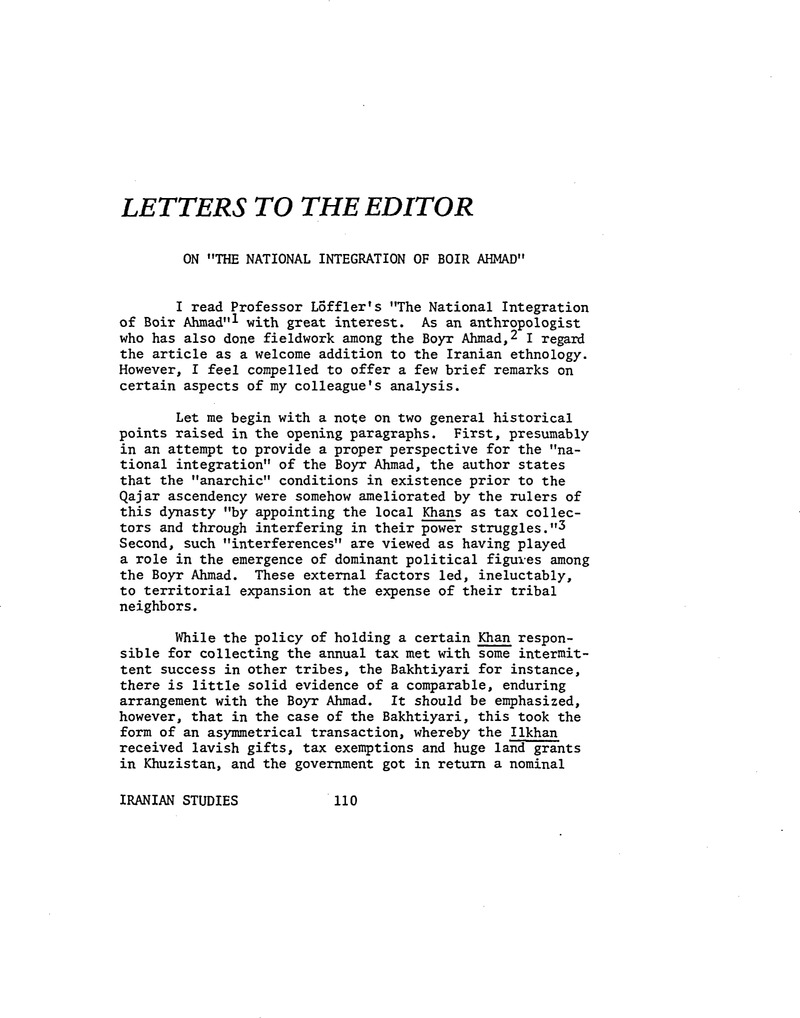No CrossRef data available.
Article contents
The National Integration of Boir Ahmad
Published online by Cambridge University Press: 01 January 2022
Abstract

- Type
- Letters to the Editor
- Information
- Copyright
- Copyright © Association For Iranian Studies, Inc 1975
References
Notes
1. Löffler, Reinhold, “The National Integration of Boir Ahmad,” Iranian Studies, Vol. VI, Nos. 2-3 (Spring-Summer, 1973), pp. 127–135CrossRefGoogle Scholar.
2. Field study among the Boyr Ahmad was carried out for a period of nineteen months between 1968-70, supported by a National Institute of Mental Health research grant and fellowship.
3. R. Löffler, op. cit., p. 127.
4. Garthwaite, Gene R., “The Bakhtiyāri Khans, the Government of Iran, and the British, 1846-1915,” Int. J. Middle East Studies, Vol. 3, No. 1 (n.d.), pp. 24–44CrossRefGoogle Scholar.
5. Reza Fazel, G., “The Encapsulation of Nomadic Societies in Iran,” in Nelson, Cynthia, ed., The Desert and the Sown: Nomads in the Wider Society, Research series, No. 21 (Institute of International Studies, University of California, Berkeley, 1973), pp. 129–143Google Scholar.
6. Bavar, Mahmud, Kuhgiluyeh and its Tribes (Gachsaran, 1944; in Persian), p. 31Google Scholar.
7. M. Bavar, op. cit., pp. 95, 98-99.
8. M. Bavar, op. cit., p. 42.
9. R. Loffler, op. cit., p. 128.
10. Lambton, Ann K. S., The Persian Land Reform 1962-1966 (Oxford: Clarendon Press, 1969), pp. 20–23Google Scholar.
11. Cf. G. Garthwaite, op. cit., p. 26; and Barth, Fredrik, Nomads of South Persia: The Basseri Tribe of the Khamseh Confederacy (Oslo University Press, 1961)Google Scholar, Ch. V.
12. Cf. Spooner, Brian “Politics, Kinship, and Ecology in Southeast Persia,” Ethnology, Vol. VIII, No 2 (1969), pp. 139–152CrossRefGoogle Scholar.
13. Löffler, R., “The Representative Mediator and the New Peasant,” American Anthropologist, Vol. 73, No. 5 (October, 1971), pp. 1077–1091CrossRefGoogle Scholar.
14. Dalton, George, “How Exactly Are Peasants Exploited?”, American Anthropologist, Vol. 76, No. 3 (September, 1974), pp. 553–561CrossRefGoogle Scholar.


